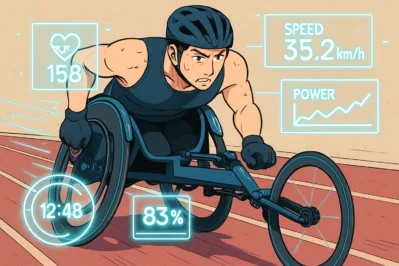Beyond Limits: Scientific Training for Para-Athletes in Korea
Hello! This is Maeil Hangeul, here to upgrade your Korean skills to an elite level!
Today, we’re diving deep into a fascinating and highly specialized field: sports science and its application to training athletes with disabilities. Whether you’re a professional in sports medicine, a coach, or simply passionate about the upper echelons of human achievement, this vocabulary will allow you to engage in sophisticated discussions on the topic.
Recently in Korea, there has been a significant surge in interest and investment in parasports, moving beyond simple participation to a focus on world-class, science-based performance. You’ll see these concepts discussed in sports documentaries and academic circles. Let’s get you ready to join that conversation!
Core Expressions for Advanced Discussion
Here are the essential terms you need to know to discuss adapting training programs for para-athletes like a professional.
1. 개별화 원칙 (Gaebyeolhwa Wonchik)
- Romanization: [Gaebyeolhwa Wonchik]
- English Meaning: Principle of Individualization
- Detailed Explanation: This is a foundational concept in all elite training, but it becomes critically important for para-athletes. It dictates that a training program must be tailored not just to the sport, but to the athlete’s specific functional ability, type of impairment, and individual physiological response. It is the absolute opposite of a “one-size-fits-all” approach and is considered the gold standard for ensuring both safety and peak performance. In professional contexts, this term is non-negotiable.
2. 수행 능력의 변인 (Suhaeng Neungnyeogui Byeonin)
- Romanization: [Suhaeng Neungnyeogui Byeonin]
- English Meaning: Variables of Performance
- Detailed Explanation: This term refers to the multitude of factors that can affect an athlete’s performance. For para-athletes, these variables are often unique and complex. Beyond standard metrics like VO2 max or one-rep max, coaches must analyze variables such as the athlete’s interface with prosthetic or adaptive equipment, asymmetrical muscle development, and unique biomechanical pathways. Discussing 수행 능력의 변인 implies a deep, analytical approach to training.
3. 기능적 등급 분류 (Gineungjeok Deunggeup Bullyu)
- Romanization: [Gineungjeok Deunggeup Bullyu]
- English Meaning: Functional Classification
- Detailed Explanation: This is the official system used in parasports to ensure fair competition. Athletes are grouped based on how their impairment affects their ability to perform the specific skills required by a sport, rather than on their medical diagnosis alone. For instance, two swimmers with different types of disabilities might be in the same class if their functional ability in the water is deemed equivalent. Understanding this term is crucial for any intelligent discussion of Paralympic competition.
4. 보완 훈련 (Bowon Hullyeon)
- Romanization: [Bowon Hullyeon]
- English Meaning: Compensatory / Supplementary Training
- Detailed Explanation: This refers to targeted training designed to strengthen the muscle groups that compensate for impaired ones or to support the primary muscles used in an adaptive movement. For a wheelchair marathoner, this would include intensive core and upper-body workouts that supplement the main act of pushing the wheels. This training is vital for maximizing power output, improving efficiency, and, crucially, preventing secondary injuries from overuse or imbalance.
Example Dialogue: At the Training Center
Here’s how these terms might be used by two sports scientists, A (박사님 – Dr. Park) and B (코치님 – Coach Lee), discussing a new para-archer.
A: 코치님, 새로 합류한 양궁 선수의 훈련 계획은 어떻게 구상하고 계신가요?
(Coach Lee, how are you conceptualizing the training plan for the new archer who just joined the team?)
B: 네, 박사님. 우선 개별화 원칙에 따라 접근하고 있습니다. 선수의 기능적 등급 분류를 기반으로 하되, 상체 안정성을 위한 특수 보완 훈련 프로그램을 추가했습니다.
(Yes, Doctor. First, I’m approaching it according to the principle of individualization. It’s based on the athlete’s functional classification, but I’ve added a special compensatory training program for upper body stability.)
A: 좋은 생각입니다. 특히 활을 지지하는 팔의 근지구력이나 심리적 압박감 같은 수행 능력의 변인들을 지속적으로 측정해서 훈련 강도를 미세 조정해야 합니다.
(That’s an excellent idea. We’ll need to continuously measure variables of performance, like the muscular endurance of the arm supporting the bow and psychological pressure, to fine-tune the training intensity.)
Cultural Tip & Trend Analysis
From Participation to Performance: In Korea, the discourse around parasports has matured dramatically. It’s now firmly in the realm of elite sports science. Major universities with sports science programs, like Seoul National University or Yonsei University, have dedicated research into adaptive sports.
When you watch a Paralympic broadcast on a Korean channel like KBS or SBS, commentators will frequently use the term 기능적 등급 분류 (Functional Classification) to explain why certain athletes are competing against each other. Understanding this allows you to appreciate the strategic complexity of the events, just like a Korean sports analyst would. You’ll sound incredibly knowledgeable if you can correctly use this term when discussing the Paralympics with Korean friends.
Wrap-up & Practice
Today, we learned four highly specialized terms that are key to discussing the scientific approach to training para-athletes: 개별화 원칙, 수행 능력의 변인, 기능적 등급 분류, and 보완 훈련. Using these will elevate your Korean to a professional, academic level.
Now, let’s test your understanding!
- Fill in the Blank: To ensure fair competition in the Paralympics, athletes undergo a rigorous _________ process based on their athletic abilities.
- (정답/Answer: 기능적 등급 분류)
- Short-Answer Question: A coach designs a specific set of core exercises for a para-snowboarder to help them maintain balance despite a lower-limb impairment. What is the Korean term for this type of targeted training?
- (정답/Answer: 보완 훈련)
Great job today! What aspect of sports science do you find most interesting? Try to use one of the terms we learned in your answer. Leave a comment below






